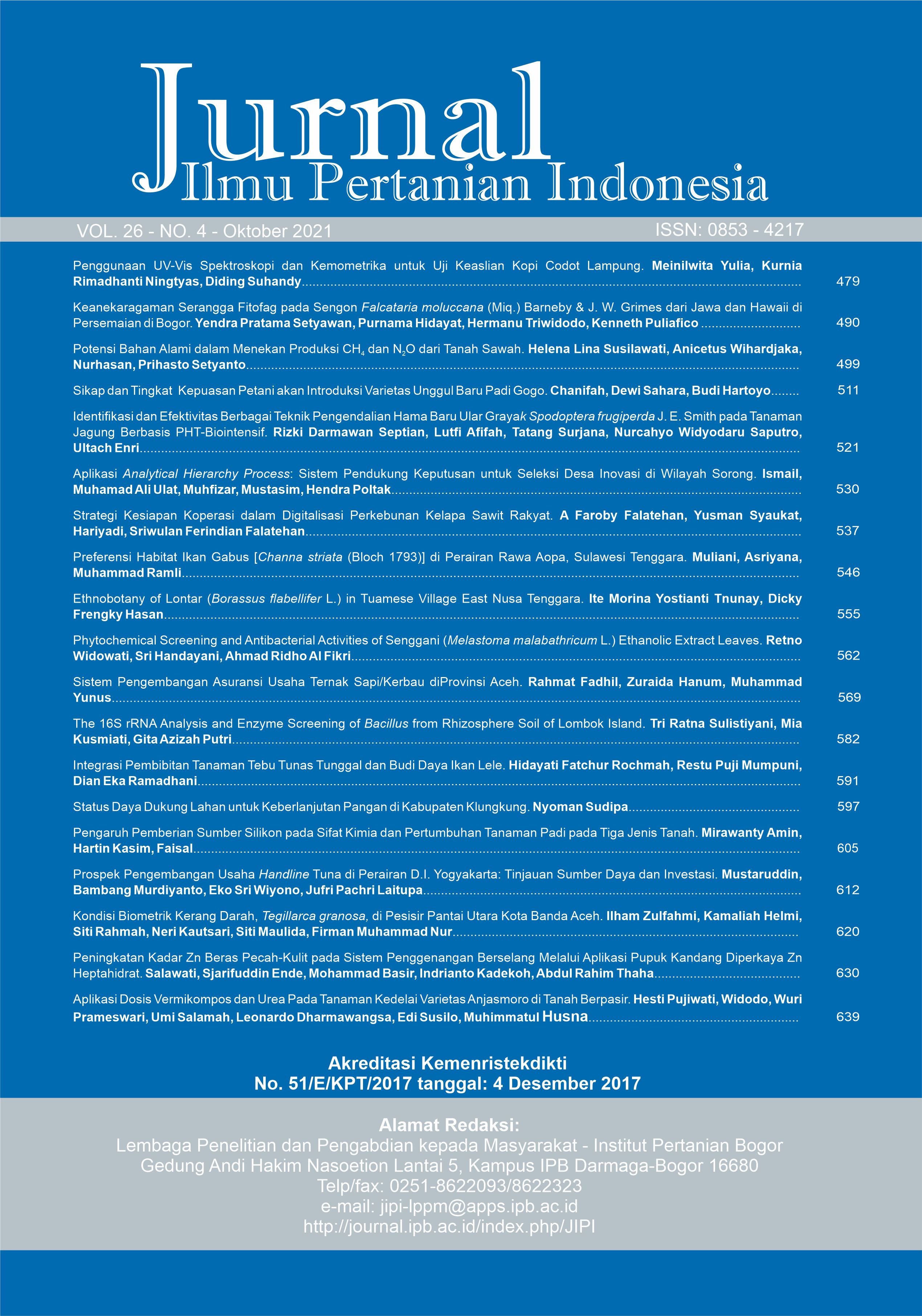Aplikasi Dosis Vermikompos dan Urea Pada Tanaman Kedelai Varietas Anjasmoro di Tanah Berpasir
Abstract
The low area for soybean plantation is still a major problem in meeting soybean needs. One of the efforts to increase national soybean production is by expanding the planting area by utilizing the sandy soil area that is still not used for soybean cultivation. This research was conducted from September-November 2020 in a greenhouse of the Agronomy Laboratory, Bengkulu University. This study aims to obtain the best dose of urea and vermicompost for the growth and yield of soybean in sandy soil. The research design used a completely randomized block design with two factors and 3 replications. The first factor was the dose of urea consisting of four levels, namely U0 = 0 kg ha-1, U1 = 50 kg ha-1, U2 = 100 kg ha-1, and U3 = 150 kg ha-1. The second factor was the dose of vermicompost, namely K0 = 0 ton ha-1, K1 = 5 tons ha-1, K2 = 10 ton ha-1, and K3 = 15 ton ha-1. The measured variables were the plant growth and the yield. Soil and vermicompost analyses were carried out before the study. The results showed that there was an interaction between the vermicompost and the urea dosages. The 100 kg ha-1 urea and the 10 ton ha-1 vermicompost treatment gave the highest plant height. The 150 kg ha-1 urea dan the 15 ton ha-1 vermicompost treatment formed the most number of branches. The highest soybean yield was given by 15 ton ha-1 vermicompost and 50 kg ha-1 urea to the total pod and the seed weight.
Keywords: sandy soil, soybean, urea, vermicompost
Downloads
References
Afandi FN, Siswanto B, Nuraini Y. 2017. Pengaruh pemberian berbagai jenis bahan organik terhadap sifat kimia tanah pada pertumbuhan dan produksi tanaman ubi jalar di Entisol Ngrangkah Pawon, Kediri. Jurnal Tanah dan Sumberdaya Lahan. 2(2): 237-244. https://jtsl.ub.ac.id/index.php/jtsl/article/vi ew/134
Arizka PS, Nurmauli N, Nurmiaty Y. 2013. Efisiensi dosis pupuk NPK majemuk dalam meningkatkan hasil kedelai varietas grobogan. Jurnal Agrotek Tropika. 1(2).
[Balitkabi] Balai Penelitian Tanaman Aneka Kacang dan Umbi. 2016. Deskripsi varietas unggul kedelai 1918-2016. http://balitkabi.litbang.pertanian.go.id/ wp-content/uploads/2016/09/kedelai.pdf
Bruun EW, Petersen C, Strobel BW, Hauggaard-Nielsen H. 2012. Nitrogen and carbon leaching in repacked sandy soil with added fine particulate biochar. Soil Science Society of America Journal. 76(4): 1142-1148. https://doi.org/10.2136/sssaj201 1.0101
Chakma M, Ali MS, Khaliq QA, Rahaman MA, Talukdar M. 2015. The effect of chemical fertilizers on the yield performance of soybean genotypes. Bangladesh Research Publications Journal. 11(3): 187-192.
Dewi WS, Sumarno, Rossati S. 2012. Potensi cacing tanah eksotik endogenik Pontiscolex corethrurus untuk produksi vermikompos granul (Vermigran) berbasis bahan organik lokal. Jurnal Caraka Tani. 27(1): 100-104. https://doi.org/10.20961/carakatani .v27i1.14364
Gourevitch JD, Keeler BL, Ricketts TH. 2018. Determining socially optimal rates of nitrogen fertilizer application. Agriculture, Ecosystems & Environment. 254: 292-299. https://doi.org/10.1016 /j.agee.2017.12.002
Hanum C. 2010. Pertumbuhan dan hasil kedelai yang diasosiasikan dengan rhizobium pada zona iklim kering E (Klasifikasi Oldeman). Bionatura. 12(3): 176-183. http://jurnal.unpad.ac.id/bionatura/article /view/7692
Hindersah R, Nabila A, Yuniarti A. 2019. Pengaruh vermikompos dan pupuk majemuk terhadap ketersediaan fosfat tanah dan hasil kentang (Solanum tuberosum L.) di andisols. Agrologia. 8(1): 21-27. https://doi.org/10.30598/a.v8i1.874
Kelik W. 2010. Pengaruh kosentrasi dan frekuensi pemberian pupuk organik cair hasil perombakan anaerob limbah makanan terhadap pertumbuhan tanaman sawi (Brassica juncea L.). Jurnal Agrosains. 19(4): 11-134.
Kementerian Pertanian. 2016. Outlook komoditas kedelai 2016. Jakarta Selatan (ID): Pusat Data dan Sistem Informasi.
Kumalasari ID, Astuti ED, Prihastanti E. 2013. Pembentukan bintil akar tanaman kedelai (Glycine max (L) Merrill) dengan perlakuan jerami pada masa inkubasi yang berbeda. Jurnal Sains dan Matematika. 21(4): 103-107. https://ejournal.undip. ac.id/index.php/sm/article/view/8046
Mayani N, Hapsoh. 2011. Potensi rhizobium dan pupuk urea untuk meningkatkan produksi kedelai (Glycine max (L)) pada lahan bekas sawah. Ilmu Pertanian Kultivar. 5(2): 67-75.
Munnoli PM, Bhosle S. 2011. Water-holding capacity of earthworms vermicompost made of sugar industry waste (press mud) in mono- and polyculture vermireactors. Enviromentalist. 31: 394-400. https ://doi.org/10.1007/s10669-011-9353-6
Pambudi S. 2013. Budidaya dan khasiat kedelai. Yogyakarta (ID): Pustaka Baru Press.
Permanasari D, Irfan M, Abizar. 2014. Pertumbuhan dan hasil kedelai (Glycine Max (L.) Merill) dengan pemberian Rhizobium dan pupuk urea pada media gambut. Jurnal Agroteknologi. 5(1): 29-34.
Rajiman, Yudono P, Sulistyaningsih E, Hanudin E. 2008. Pengaruh pembenah tanah terhadap sifat fisika dan hasil bawang merah pada lahan pasir pantai Bugel Kabupaten Kulon Progo. Agrin: Agricultural Reseach and Information. 12(1): 67-77. https://repository.ugm.ac.id/id/eprint/32410
Ramadhani RH, Roviq M, Maghfoer MD. 2016. Pengaruh sumber pupuk nitrogen dan waktu pemberianurea pada pertumbuhan dan hasil tanaman jagung manis (Zea mays. Sturt. var. saccharata). Jurnal Produksi Tanaman. 4(1): 8-15. http://protan.studentjournal.ub.ac.id/index.php/protan/article/view/254
Rosmarkam A, Yuwono NW. 2002. Ilmu kesuburan tanah. Yogyakarta (ID): Penerbit Kanisius.
Syahrudin. 2011. Respon tanaman seledri (Apium graveolus L.) terhadap pemberian beberapa macam pupuk daun pada tiga jenis tanah. Jurnal Agri Peat. 12(1).
Tauhidah NA, Rosyidah A, Nurhidayati. 2018. Efek pemberian kombinasi vermikompos berbehan aditif biochar dan pupuk anorganik terhadap pertumbuhan dan kadar hara N, P dan K tanaman brokoli (Brassica oleraceae L.) pada tanah berpasir. Jurnal Folium. 2(1): 42-54.
Xiang DB, Yong TW, Yang WY, Gong WZ, Cui L, Lei T. 2012. Effect of phosphorus and potassium nutrition on growth and yield of soybean in relay strip intercropping system. Scientific Research and Essays. 7(3): 342-351.
Yoseftabar S. 2012. Effect of nitrogen and phosphorus fertilizer on growth and yield rice (Oryza sativa L). International Journal of Agronomy and Plant Production. 3(12): 579-584.
This journal is published under the terms of the Creative Commons Attribution-NonCommercial 4.0 International License. Authors who publish with this journal agree to the following terms: Authors retain copyright and grant the journal right of first publication with the work simultaneously licensed under a Creative Commons Attribution-NonCommercial 4.0 International License. Attribution — You must give appropriate credit, provide a link to the license, and indicate if changes were made. You may do so in any reasonable manner, but not in any way that suggests the licensor endorses you or your use. NonCommercial — You may not use the material for commercial purposes.























